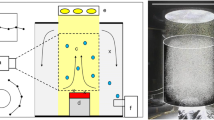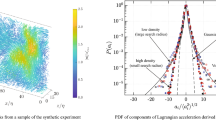Abstract
We address the problem of making quantitative measurements of local flow velocities in turbulent liquid helium, using tracer particles. We survey and evaluate presently available particles and previous work to establish the need to develop new particles for the purpose. We present the first practical solution for visualizing fluid motions using a suspension of solid hydrogen particles with diameters of about 2 μm. The hydrogen particles can be used to study flows with Taylor-microscale Reynolds numbers between 85 and 775. The particles can be used equally well with the PIV, LDV, or particle-tracking techniques.



Similar content being viewed by others
Abbreviations
- A :
-
Hamaker’s constant
- d :
-
particle diameter
- g :
-
acceleration of gravity
- k B :
-
Boltzmann’s constant
- L :
-
characteristic size of the large eddies
- N :
-
number of particles
- n :
-
number of particles per unit volume
- T :
-
temperature
- U :
-
characteristic velocity of the large eddies
- u :
-
local and instantaneous fluid velocity
- V p :
-
total volume of the particles
- V f :
-
total volume of the fluid
- V o :
-
volume of laser sheet that is visible to the camera
- v :
-
particle velocity
- Δρ :
-
density difference between particle and fluid
- ε :
-
mean energy dissipation rate
- Φ :
-
volume fraction of particles in the fluid
- μ :
-
dynamic viscosity of the fluid
- ν :
-
kinematic viscosity of the fluid
- ρ f :
-
mass density of the fluid
- ρ p :
-
mass density of the particle
References
Adrian RJ, Yao CS (1983) Development of pulsed laser velocimetry for measurement of fluid flow. In: Patterson G, Zakin JL (eds) Proceedings, eighth biennial symposium on turbulence. University of Missouri, Rolla
Batchelor GK (1967) An introduction to fluid dynamics. Cambridge University Press, Cambridge
Bewley GP (2006) Using hydrogen particles to observe rotating and quantized flows in liquid helium. PhD Thesis, Yale University
Bewley GP, Lathrop DP, Maas LRM, Sreenivasan KR (2007) Inertial waves in rotating grid turbulence. Phys Fluids 19:071701
Bewley GP, Lathrop DP, Sreenivasan KR (2006) Visualizing quantized vortices. Nature 441:588
Boltnev RE, Frossati G, Gordon EB, Krushinskaya IN, Popov EA, Usenko A (2002) Embedding impurities into liquid helium. J Low Temp Phys 127:245–258
Castaing B, Chabaud B, Hebral B (1992) Hot wire anemometer operating at cryogenic temperatures. Rev Sci Instrum 63:2442–2446
Celik D, Smith MR, Van Sciver SW (1999) A particle seeding apparatus for cryogenic visualization. Adv Cryog Eng 45:1175–1180
Celik D, Van Sciver SW (2002) Tracer particle generation in superfluid helium through cryogenic liquid injection for particle image velocimetry (PIV) applications. Exp Therm Fluid Sci 26:971–975
Chopra KL, Brown JB (1957) Suspension of particles in liquid helium. Phys Rev 108:157
Chung DY, Critchlow PR (1965) Motion of suspended particles in turbulent superflow of liquid helium II. Phys Rev Lett 14:892–894
Frisch U (1995) Turbulence: the legacy of A.N. Kolmogorov. Cambridge University Press, Cambridge
Fuzier S, Van Sciver SW (2001) Steady-state pressure drop and heat transfer in He II forced flow at high Reynolds number. Cryogenics 41:453–458
Hiemenz PC, Rajagopalan R (1997) Principles of colloid and surface chemistry. Marcel Dekker, New York
Huber G, Wirth KE (2003) Electrostatically supported surface coating of solid particles in liquid nitrogen for use in dry-powder inhalers. Powder Tech 134:181–192
Kitchens TA, Steyert WA, Taylor RD (1965) Flow visualization in He II: direct observation of Helmholtz flow. Phys Rev Lett 14:942–945
Kolmogorov AN (1941) The local structure of turbulence in incompressible viscous fluid for very large Reynolds numbers. Proc R Soc Lond A Math Phys Sci 434:9–13 (1991)
Maxey MR, Riley JJ (1983) Equation of motion for a small rigid sphere in a nonuniform flow. Phys Fluids 26:883–889
Mei MR (1996) Velocity fidelity of flow tracer particles. Exp Fluids 22:1–13
Mei MR, Adrian RJ, Hanratty TJ (1990) Particle dispersion in isotropic turbulence under stokes-drag and basset force with gravitational settling. J Fluid Mech 225:481–495
Monin AS, Yaglom AM (1975) Statistical fluid mechanics, vol 2. MIT Press, Cambridge
Murakami M, Ichikawa N (1989) Flow visualization study of thermal counterflow jet in He II. Cryogenics 29:438–443
Nakano A, Murakami M (1992) Measurement of second sound Helmholtz oscillation in He II using laser Doppler velocimeter. Adv Cryog Eng 37A:97–103
Niemela JJ, Sreenivasan KR (2006) The use of cryogenic helium for classical turbulence: promises and hurdles. J Low Temp Phys 143:163–212
Palaanen MA, Iye Y (1985) Electron mobility on thin He films. Phys Rev Lett 55:1761–1764
Poole DR, Barenghi CF, Sergeev YA, Vinen WF (2005) Motion of tracer particles in He II. Phys Rev B 71:064514
Reeks MW (1977) On the dispersion of small particles suspended in an isotropic turbulent fluid. J Fluid Mech 83:529–546
Saffman PG, Turner JS (1956) On the collision of drops in turbulent clouds. J Fluid Mech 1:16–30
Skrbek L (2004) Turbulence in cryogenic Helium. Physica C 404:354–362
Skrbek L, Niemela JJ, Donnelly RJ (1999) Turbulent flows at cryogenic temperatures: a new frontier. J Phys Condens Matter 11:7761–7781
Smith MR, Hilton DK, Van Sciver SW (1999) Observed drag crisis on a sphere in flowing He I and He II. Phys Fluids 11:751–753
Sonntag RC, Russel WB (1986) Structure and breakup of flocs subjected to fluid stresses I. Shear experiments. J Colloid Interface Sci 13:399–413
Sreenivasan KR (1984) On the scaling of the turbulence energy dissipation rate. Phys Fluids 27:1048–1051
Sreenivasan KR (1999) Fluid turbulence. Rev Mod Phys 71:S383–S395
Sreenivasan KR, Donnelly RJ (2001) Role of cryogenic helium in classical fluid dynamics: basic research and model testing. Adv Appl Mech 37:239–276
Takakoshi T, Murakami M (2006) Application of PIV technology to superfluid He II thermal counterflow jet. Proc ICEC 21
Voth GA, La Porta A, Crawford AM, Alexander J, Bodenschatz E (2002) Measurement of particle accelerations in fully developed turbulence. J Fluid Mech 469:121–160
Vold RD, Vold MJ (1983) Colloid and interface chemistry. Addison Wesley, Reading, MA
Wegener PP, Sreenivasan KR (1981) The effect of cooling rate on binary nucleation. Appl Sci Res 37:183–194
Wells MR, Stock DE (1983) The effects of crossing trajectories on the dispersion of particles in a turbulent flow. J Fluid Mech 136:31–62
White CM (2001) High Reynolds number turbulence in a small apparatus. PhD Thesis, Yale University
White CM, Karpetis AN, Sreenivasan KR (2002) High-Reynolds-number turbulence in small apparatus: grid turbulence in cryogenic liquids. J Fluid Mech 452:189–197
Xu T, Van Sciver SW (2006) Solid H2/D2 particle seeding and injection system for PIV measurement in He II. Adv Cryog Eng 51B:1685
Zhang T, Celik D, Van Sciver SW (2004) Tracer particles for application to PIV studies of liquid helium. J Low Temp Phys 134:985–1000
Zhang T, Van Sciver SW (2005) The motion of micron-sized particles in He II counterflow as observed by the PIV technique. J Low Temp Phys 138:865–870
Acknowledgments
The National Science Foundation of the USA and NASA supported this work. We wish to thank Chris White for guidance, and Russ Donnelly, Joe Niemela, Steve Predko, and Joe Vinen for the cryostat.
Author information
Authors and Affiliations
Corresponding author
Appendix
Appendix
We have observed the aggregation of several types of particles in liquid helium, and we argue here that aggregation may be unavoidable in this fluid. The forces that draw particles together are the same as the ones that binds the molecules of the particle together to form a solid, known as the van der Waals forces. This force overwhelms Brownian motion for particles that come close to each other, as we see if we consider the attractive potential, U D, between two spheres with center to center separation r and with radius a,
which is a function of Hamaker’s constant, A (Vold and Vold 1983). Thermal energy is measured by E T = k B T ≈ 6 × 10−23 J, where k B is Boltzmann’s constant, and T is the temperature, and the value is given for T = 4.2 K. The value of r for which U D = E T is approximately r c = 4a, using Hamaker’s constant for polystyrene, A = 8 × 10−20 J, although the Hamaker constant for most materials is of the same order. Note that an exception is liquid helium, and since Hamaker’s constant for liquid helium is much smaller (Paalanen and Iye 1985), we do not need to account for it as the intervening fluid (Hiemenz and Rajagopalan 1997). Within 2 diameters, the van der Waals potential rises sharply, and it is therefore unlikely that thermal fluctuations will separate particles under its influence.
Most methods to prevent particles from coalescing under the influence of the van der Waals potential are inapplicable in liquid helium. The first, steric stabilization, can be accomplished by manufacturing particles with a surface coating or by adding a surfactant. This solution depends on the flexibility of polymer molecules (Vold and Vold 1983), and in liquid helium the mechanism fails because its temperature is below the glass transition temperature of all polymers. The second method uses electrostatic repulsion. To exploit this force, one can manufacture particles with polar groups on the particle surface, or cause the particles to accumulate free ions. The dissociation of an ion that allows the formation of a polar group requires a polar solvent, such as water. Since helium is nonpolar, this solution is inapplicable. However, adding an electrostatic charge to particles was implemented successfully in liquid nitrogen (Huber and Wirth 2003), and the method is potentially useful for dispersing particles in liquid helium.
Since the van der Waals potential given in (19) diverges to infinity as the separation between particles becomes smaller, the theory predicts that particles are inseparable once they come into contact. Without a method to prevent particles from coalescing, one must know the mechanical properties of the particles, or perform experiments to measure the strength of the bond between particles under the relevant conditions, to understand how to break particle aggregates apart. We are not aware of such work having been done.
It is known that the shear inherent to turbulence both causes particle collisions (Saffman and Turner 1956) and breaks apart particle aggregates (Sonntag and Russel 1986). Based on the above discussions, we assume that turbulence cannot break aggregates at the intensity we are able to generate it. If particles are inseparable, we estimate the rate of aggregate growth as follows. Saffman and Turner (1956) give a solution for the particle number density as a function of time under the assumption that the collision frequency is independent of particle size:
Here, n is the total number of particles per unit volume, with initial value n 0, and α is the collision frequency, where α = 1.30a 3 νRe 3/2/L 2. The time for the particle number to halve is
where Φ is the volume fraction of particles relative to the fluid, and is equal to 4πa 3 n 0/3.
For typical conditions in turbulent liquid helium, the time constant given by (21) is about 5 min. This indicates that if particles of the desired initial size were dispersed, there exists a useful period of time during which they are fluid tracers. However, τ 1/2 is inversely proportional to the particle volume fraction. If the particles must be injected into the fluid as a concentrated solution, and this process is necessarily turbulent, then at the time of injection and near the injector the volume fraction of particles is larger than in the fully dispersed solution. For particles at an initial volume fraction of 0.1 injected at 10 cm/s through a 3-mm injector, τ 1/2 is reduced to about 0.01 s. This leaves little time for the particles to leave the injector before they irreversibly clump into larger particles.
Rights and permissions
About this article
Cite this article
Bewley, G.P., Sreenivasan, K.R. & Lathrop, D.P. Particles for tracing turbulent liquid helium. Exp Fluids 44, 887–896 (2008). https://doi.org/10.1007/s00348-007-0444-6
Received:
Revised:
Accepted:
Published:
Issue Date:
DOI: https://doi.org/10.1007/s00348-007-0444-6




